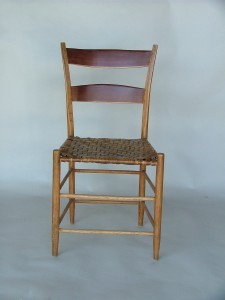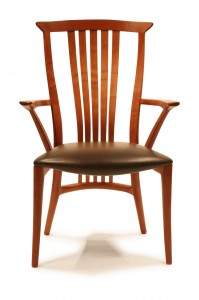We may receive a commission when you use our affiliate links. However, this does not impact our recommendations.
In the November 2012 issue of Popular Woodworking Magazine, a special 200th anniversary issue celebrating some of the best makers working today, I wrote a piece on chairmaker Brian Boggs. In doing so I spent a day in Brian’s shop and gallery in the Biltmore Village in Asheville, North Carolina, where we talked about everything from his first foray’s into chairmaking to his new business venture, the Boggs’ Collective, wherein Brian partners in a number of different ways with various furniture and cabinet makers. Brian is always a thoughtful and eloquent woodworker. Being a bit of a furniture design nerd and a chairmaker myself, I was most interested to hear Brian’s thoughts on the design process. Instead of attempting to summarize his thoughts here, I’ll let Brian speak for himself in this excerpt from our interveiw:
 “I sketch a gesture drawing first – a rough sketch where you try to capture movement and proportions, but not necessarily accurately. You just try to get the gist of it. And I generally go from there to kind of a wooden gesture form. My initial mock ups are like a wooden gesture drawing. They’re just the idea.
“I sketch a gesture drawing first – a rough sketch where you try to capture movement and proportions, but not necessarily accurately. You just try to get the gist of it. And I generally go from there to kind of a wooden gesture form. My initial mock ups are like a wooden gesture drawing. They’re just the idea.
“Now I don’t need to experiment. I am really happy with the comfort of the chairs and that’s something that I can transfer. Those are all numbers. They’re angles and curves but they’re numbers and they’re numbers that I know and I can always repeat them. No matter how the chair is constructed I preserve that form. That’s not an experiment. That’s the design process I build around. I’ve got a seat to back angle. The seat, back, and the floor are three lines that are constant. So I can draw those with a sharpie pen and put vellum over it. That’s real helpful because it allows me to gesture draw around those. I’ve got the proportions right and then I can freely play with visual form.
“And then I think about the movement of the piece. I say ‘think about’ . . . . That’s really not the right word because you know I think design at it’s best is a free download. Its not a thinking that comes from us it’s just a inspiration that’s a download. And I think that people that are really good at it, creative people, they’ve just opened up the channel that allows the download to happen. And the more you start thinking, left-brain analyzing something, the more you get in the way. It’s hard to do that and not get in the way of the creative process which is just an opening and a listening to what’s trying to happen. Something is always trying to happen. Some design always seems like it’s looking for a place to be born and if we’re open to it then something cool can happen, so that’s what the gesture drawing is really helpful at – just opening things without restricting anything, to allow a movement to happen. It’s like when you have writers block it’s best to just start writing shit even if it makes no sense at all to just open up the pipeline. You gotta prime it with something. It might be junk but the gesture drawing is a way of priming the pump, of giving it a place to go. And you’ve just got to keep playing with that. And eventually it starts to take form and then I start to see where the structure needs to be in order to support the movement.
“What I’m trying to do, is capture a feeling with a new design. And that is the value of any creative endeavor whether it’s writing, painting, or woodworking. It’s to express, sometimes it’s to express an idea, an intellectual idea, but certainly artistic stuff, you know writing a novel. You want to be able to have the emotion of that thing or connect with the viewer or the sitter, you want to connect to them in a way that they feel somewhat enriched, at least I do, and that can’t be thought through very much, that has to be felt. And I use my the way a piece feels as I draw it and I look at it, as I mock it up to guide the design and then where to support it structurally that happens from a gesture drawing too. And then how to design the joint is a little bit like that but it’s also that gets to be a little more left brain engineering, thinking through solutions and you know like anything else you build on your past nuts and bolts kind of stuff. When you add a new thread to something that is a new direction. You know, adding a router to a woodworking shop that only had a chisel already opens up a and actually the router has been absolutely key to my ability to design freely because a router can travel in any direction that you can imagine guiding it and it can cut any shape or angle or whatever that you can imagine guiding it to cut. 
“I wasn’t going to get into this and maybe it’s not accessible, But I have a natural tendency to merge with what I’m working with. So, for example. I’ll just sit and stare at that mock up and let everything go away it’s kind of a meditation. And what needs to happen just shows up. And so design, as much as anything else, for me, is just a matter of get the hell out of the way and let it happen. Because it’s trying to happen. I’m not going to make it happen. I’m just going to make myself available to something that is trying to happen and whether that’s a reality or a perception it does change the game a lot in that I am softening and allowing something to have a life of it’s own rather than enforcing my structural sense onto something from an egoic standpoint.
“I think the designs have a much more sensitive and sensual feeling about them from across the room than they would otherwise. And I think that’s the most important thing a designer can do is to design in a way that someone walks into the room and feels something from that piece before touching it or sitting in it. And if you don’t feel something, there’s something missing. And maybe it’s the person, some people are just not very sensitive. But I want my work to connect with people and if I’m not paying attention to it, listening to it, and letting it be created then there is no hope of it being able to connect with anybody else. So, that’s not a specific process but a real core element of the way I design and it’s not something I ever thought through it’s just something I observed over the years: this is my pattern.”
To see more from Brian Boggs, check out one of his DVDs:
Hickory Bark from Tree to Chair, Weaving Hickory Bark Seat or Drawknives, Spokeshaves and Travishers: A Chairmaker’s Tool Kit.
Here are some supplies and tools we find essential in our everyday work around the shop. We may receive a commission from sales referred by our links; however, we have carefully selected these products for their usefulness and quality.








My wife and I visited Brian’s shop while in Asheville earlier this year. He took the time to give us a tour of his shop. We were both quite impressed by his easy going personality and his vast knowledge. At the time he was refurbishing a band saw for use in the shop.